Ryanodine receptors contribute to bile acid-induced pathological calcium signaling and pancreatitis in mice.
Sohail Z Husain, Abrahim I Orabi, Kamaldeen A Muili, Yuhuan Luo, Sheharyar Sarwar, Syeda Maham Mahmood, Dong Wang, Rayman Choo-Wing, Vijay P Singh, Jerome Parness, Meena Ananthanaravanan, Vineet Bhandari, George Perides
Index: Am. J. Physiol. Gastrointest. Liver Physiol. 302(12) , G1423-33, (2012)
Full Text: HTML
Abstract
Biliary pancreatitis is the most common etiology for acute pancreatitis, yet its pathophysiological mechanism remains unclear. Ca(2+) signals generated within the pancreatic acinar cell initiate the early phase of pancreatitis, and bile acids can elicit anomalous acinar cell intracellular Ca(2+) release. We previously demonstrated that Ca(2+) released via the intracellular Ca(2+) channel, the ryanodine receptor (RyR), contributes to the aberrant Ca(2+) signal. In this study, we examined whether RyR inhibition protects against pathological Ca(2+) signals, acinar cell injury, and pancreatitis from bile acid exposure. The bile acid tauro-lithocholic acid-3-sulfate (TLCS) induced intracellular Ca(2+) oscillations at 50 μM and a peak-plateau signal at 500 μM, and only the latter induced acinar cell injury, as determined by lactate dehydrogenase (LDH) leakage. Pretreatment with the RyR inhibitors dantrolene or ryanodine converted the peak-plateau signal to a mostly oscillatory pattern (P < 0.05). They also reduced acinar cell LDH leakage, basolateral blebbing, and propidium iodide uptake (P < 0.05). In vivo, a single dose of dantrolene (5 mg/kg), given either 1 h before or 2 h after intraductal TLCS infusion, reduced the severity of pancreatitis down to the level of the control (P < 0.05). These results suggest that the severity of biliary pancreatitis may be ameliorated by the clinical use of RyR inhibitors.
Related Compounds
| Structure | Name/CAS No. | Molecular Formula | Articles |
|---|---|---|---|
 |
TAUROLITHOCHOLIC ACID SODIUM SALT
CAS:6042-32-6 |
C26H44NNaO5S |
|
Bile acid receptor TGR5 agonism induces NO production and re...
2013-07-01 [Arterioscler. Thromb. Vasc. Biol. 33(7) , 1663-9, (2013)] |
|
Angiotensin II protects primary rat hepatocytes against bile...
2012-01-01 [PLoS ONE 7(12) , e52647, (2012)] |
|
Bile acids induce pancreatic acinar cell injury and pancreat...
2013-01-04 [J. Biol. Chem. 288(1) , 570-80, (2013)] |
|
Complexation of tauro- and glyco-conjugated bile salts with ...
2007-10-01 [Electrophoresis 28(20) , 3745-52, (2007)] |
|
The bile acid receptor TGR5 (Gpbar-1) acts as a neurosteroid...
2010-11-15 [Glia 58(15) , 1794-805, (2010)] |